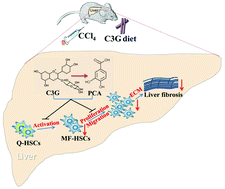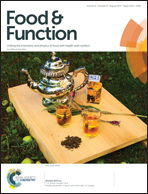Cyanidin-3-O-β-glucoside combined with its metabolite protocatechuic acid attenuated the activation of mice hepatic stellate cells†
Abstract
Previous studies indicated that cyanidin-3-O-β-glucoside (C3G) as a classical anthocyanin exerted an anti-fibrotic effect in the liver, but its bioavailability was quite low. This study was undertaken to explore the restraining effect of C3G and its metabolite protocatechuic acid (PCA) on the activation of hepatic stellate cells (HSCs). Our data demonstrated that the treatment of a carbon tetrachloride-treated mice model with C3G inhibited liver fibrosis and HSC activation. In vitro, both C3G and PCA preserved the lipid droplets and retinol in primary HSCs, and additionally inhibited the mRNA expression of α-smooth muscle actin and collagen I, but elevated the level of matrix metalloproteinase-2 and liver X receptors. Only PCA suppressed the levels of tumor necrosis factor alpha (TNF-α) and interleukin-6 (IL-6) secreted from HSCs significantly. In addition, C3G and PCA inhibited the proliferation and migration of HSCs. In conclusion, PCA mainly explained the in vivo inhibiting effect of C3G on HSC activation and liver fibrosis.



 Please wait while we load your content...
Please wait while we load your content...